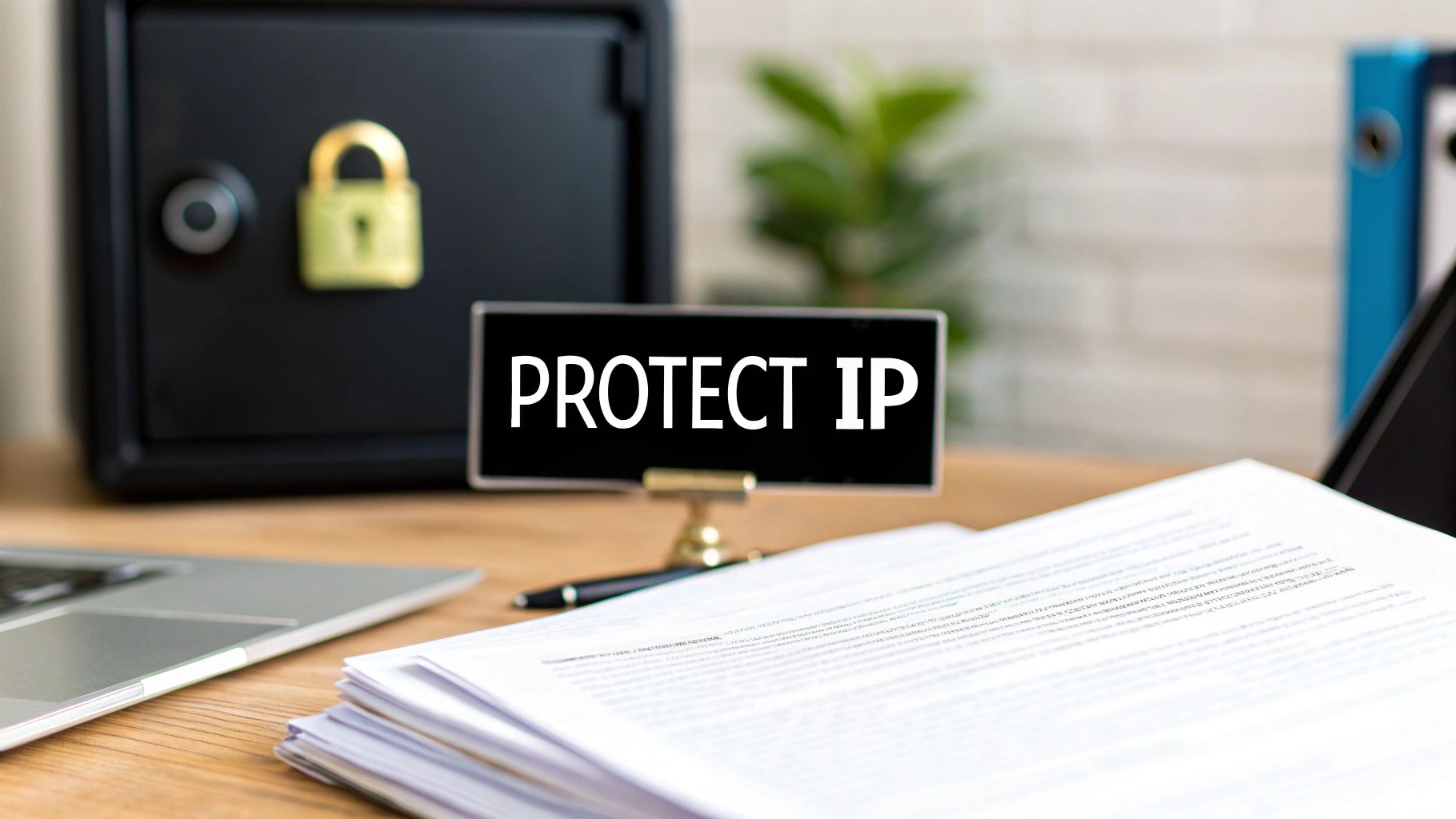Protecting your intellectual property isn't just a legal formality; it's about building a fortress around your most valuable creations. It starts with a simple but crucial step: figuring out what you actually have—whether it’s a groundbreaking invention, a memorable brand name, or a secret recipe—and then officially registering it with the right government agencies. This gives you the legal muscle to stop others from using your work without permission.
First Steps in Protecting Your Intellectual Property
Before you can defend your ideas, you need a clear inventory of what you're protecting. It sounds obvious, but you'd be surprised how many entrepreneurs skip this step. Getting to grips with the different kinds of intellectual property (IP) is the bedrock of any solid protection strategy. If you misclassify an asset, you could end up with the wrong kind of protection, or worse, no protection at all.
This isn't just about paperwork; it's a strategic business move. The market for IP protection services is expected to explode, growing from USD 46.73 billion in 2025 to USD 76.71 billion by 2031. That massive jump tells you that smart businesses are taking this seriously and investing heavily in safeguarding their innovations.
The Four Main Types of IP
Most intellectual assets fit into one of four buckets. Each one is designed to protect a different kind of creation, so knowing the difference is essential to avoid wasting time and money.
- Patents: These are for inventions—the "how it works."
- Trademarks: These protect your brand identity—names, logos, and slogans.
- Copyrights: These cover original creative works, like text, music, or software code.
- Trade Secrets: This is for confidential business information that gives you a competitive edge.
Let's use a real-world example. Imagine a new coffee machine. A patent would protect the unique brewing mechanism inside. The brand name and logo on the machine would be covered by a trademark. The user manual and the jingle it plays when the coffee is ready? That's copyright. And the secret blend of materials used to make the machine so durable could be a trade secret. Each piece needs its own specific protection.
One of the biggest mistakes I see is business owners thinking one IP registration covers everything. A single product is often a bundle of different intellectual properties, and each one needs to be protected individually.
Four Main Types of Intellectual Property at a Glance
To help you get a handle on what you have, here's a quick comparison of the four main IP categories. This table breaks down what each type protects, offers a clear example, and outlines how long that protection typically lasts.
Seeing them side-by-side makes it easier to start sorting your own assets into the right categories. Once you know what you're working with, you can build a strategy that truly protects your business's future.
Get Clear on Your Assets
Let's make this even more practical. The Nike "swoosh" is a perfect example of a trademark. You see it, you instantly know who made the product. The legendary formula for Coca-Cola is one of the most famous trade secrets in the world; its value comes from the fact that it's kept under lock and key, not from a government certificate.
Your own brand elements—your logo, business name, and taglines—are more than just pretty designs. It’s worth taking the time to understand https://www.softriver.co/blog/what-are-brand-assets-your-guide-to-building-business-value and how they contribute to your bottom line.
This infographic gives a great visual summary of how long the three most common forms of registered IP last.
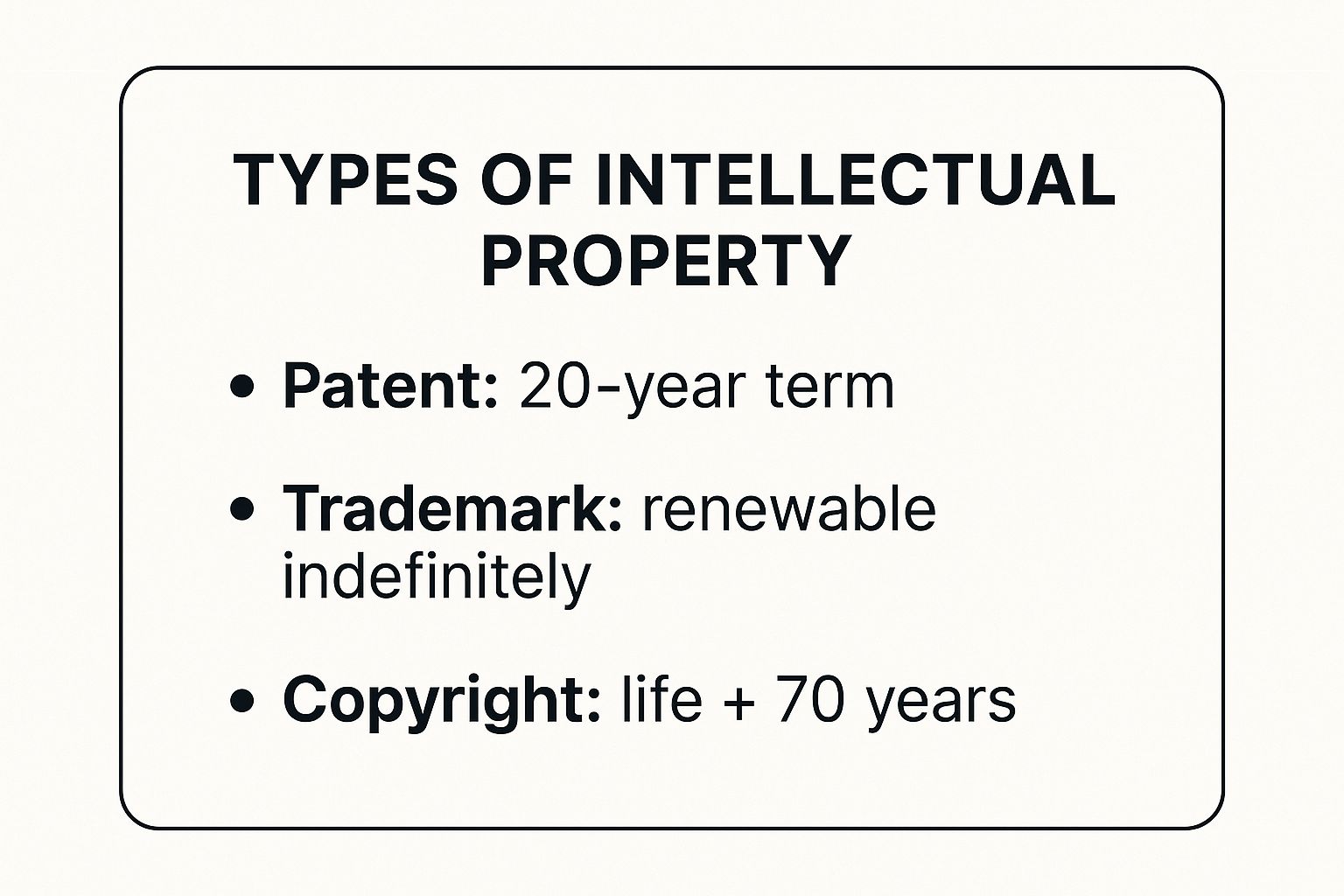
As you can see, trademarks are a powerful long-term asset because you can renew them forever as long as you're still using them in your business.
Taking the time to properly identify and classify your assets is the essential first move. If you need more comprehensive Intellectual Property legal guidance, working with specialists can help you navigate the entire process, from registration to enforcement. How you classify your IP from day one will shape every decision you make down the road.
Navigating the Patent Process for Your Inventions
Patents are the gold standard for protecting a new invention. They give you the exclusive right to make, use, and sell your creation for up to 20 years, which can be an incredibly powerful asset. But getting a patent isn't just about filling out some forms; it's a meticulous, strategic journey where precision is everything. A clear plan can mean the difference between owning a valuable piece of IP and facing a costly rejection.
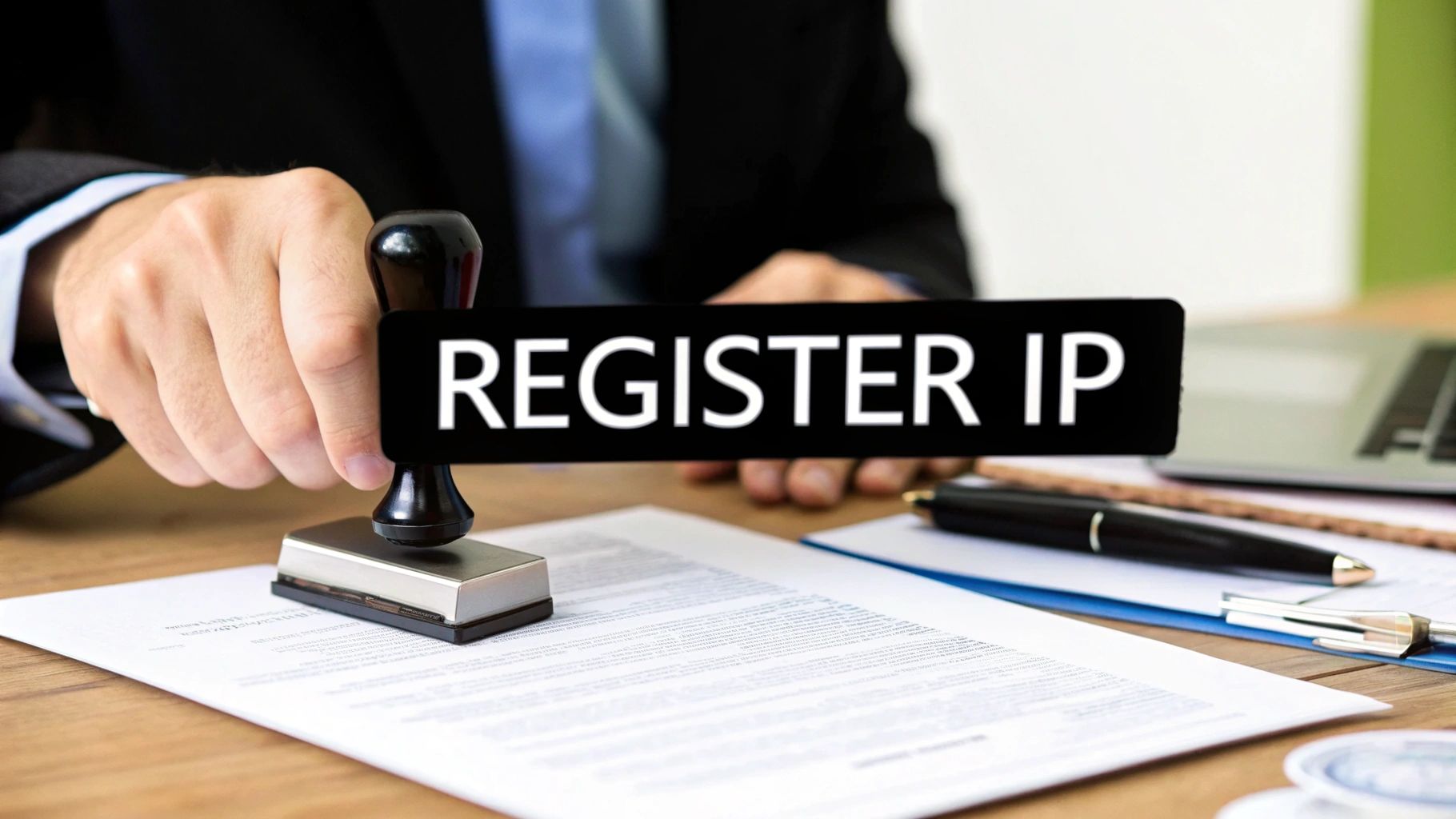
The first step, and honestly the most important, is the patent search. Before you sink a dime into the application process, you have to do your homework to make sure your invention is genuinely new and non-obvious. This is non-negotiable. If something similar—what the legal world calls "prior art"—already exists, your application is dead in the water.
Conducting a Thorough Patent Search
A real search means digging deep into databases like the one from the U.S. Patent and Trademark Office (USPTO) and other international patent offices. You're not just looking for a carbon copy of your idea. You’re also hunting for individual components or concepts that, if pieced together, could make your invention seem "obvious" to someone in your field.
Here’s a real-world example: A startup I know developed a smart coffee mug that used a novel battery to keep the drink at a perfect temperature. Their search turned up a patent for a similar temperature-control mechanism, but it was for an industrial machine. While not a direct conflict, this prior art forced them to get laser-focused with their patent claims, zeroing in on the unique application for consumer beverage containers. That small but crucial pivot saved their application.
A classic mistake I see all the time is inventors only searching for products they can buy. A patent is valid even if the invention was never sold. Your search has to cover every patent ever filed, not just what's on Amazon.
Once you’re confident your idea is novel, you can move on to preparing the application itself. Think of this document as a highly technical legal instrument—every single word counts.
Crafting a Compelling Patent Application
Your application is your sales pitch to the patent examiner. It’s your one shot to prove your invention is worthy of protection. It has a few critical parts:
- Specification: This is where you lay it all out. You have to describe your invention in such excruciating detail that another expert in your field could build and use it just from your description. If you're vague here, the examiner will send it right back.
- Claims: This is the most important part from a legal standpoint. The claims are the fences you build around your IP, defining exactly what you own. They are written in a very specific, formal language and will be scrutinized more than any other section.
- Drawings: Most inventions need detailed illustrations. These aren’t just sketches; they have to show every feature you mentioned in your claims and must follow the patent office's strict formatting rules to the letter.
This isn’t creative writing. It's a balancing act—you want your claims to be broad enough to stop copycats from making a slightly different version, but narrow enough to get past the examiner.
Provisional vs. Non-Provisional Applications
For many inventors, a provisional patent application (PPA) is a fantastic first move. It’s a cheaper, less formal filing that locks in your filing date and lets you use the coveted "patent pending" status for one year. This buys you precious time to test the market, look for funding, or refine your invention before you commit to the much more expensive non-provisional application.
Think of a software developer with a groundbreaking new algorithm. She can file a PPA in a matter of days to protect her idea before pitching it to investors. This move secures her priority date, so any similar ideas filed after hers won't count as prior art against her.
But remember, a PPA is just a placeholder. You must file the full non-provisional application within that one-year window, or you lose everything—your filing date, your protection, all of it. Knowing how to protect intellectual property with patents means using these tools to your best advantage.
Building and Defending Your Brand with Trademarks
Your brand is so much more than a logo or a catchy name. It’s the gut feeling a customer gets when they think of you. It's your reputation, your promise, and frankly, one of your most valuable assets. Protecting that identity isn't just a good idea—it's absolutely critical for long-term survival and growth. This is where trademarks step in, acting as your legal shield.
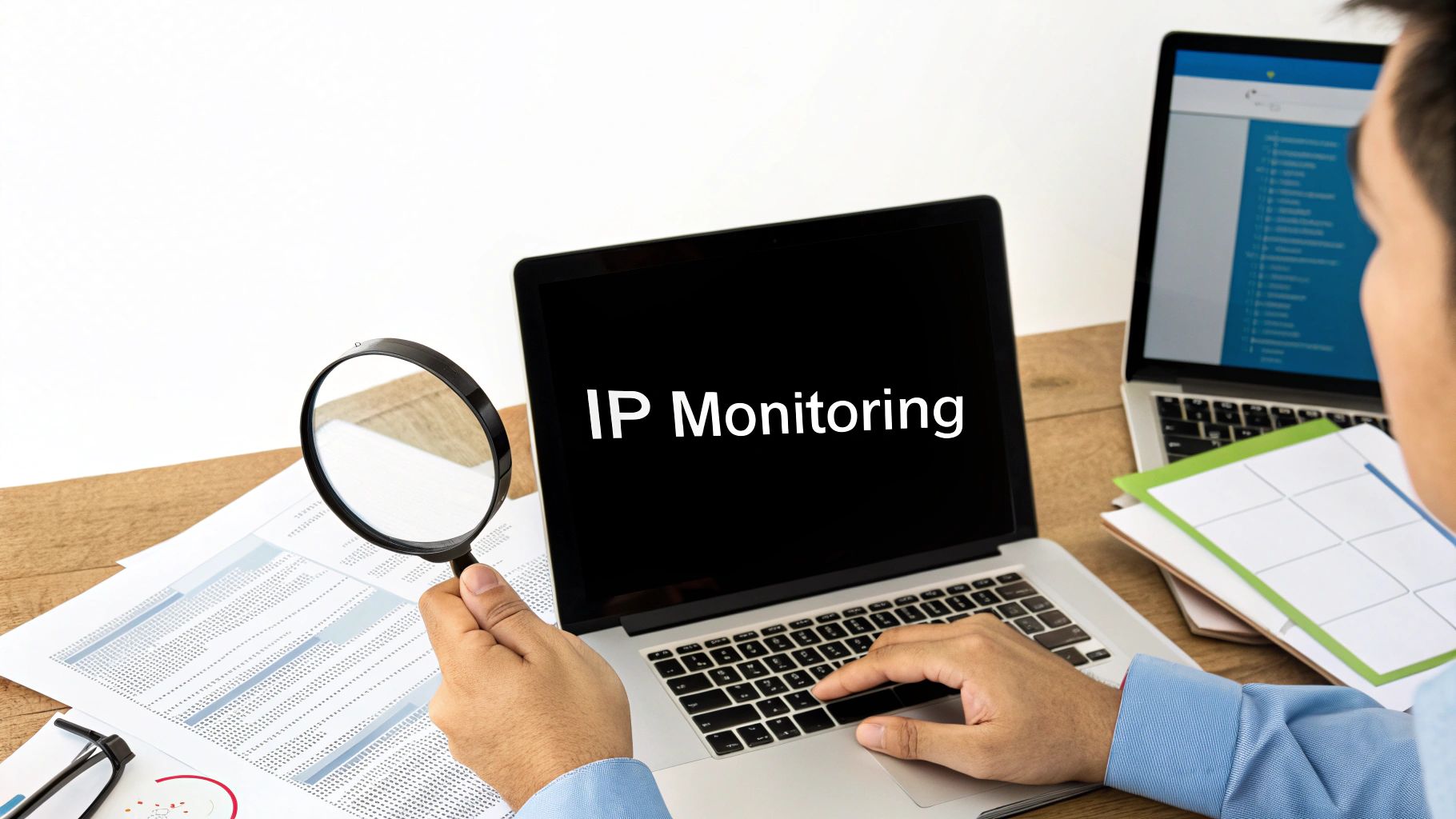
A trademark can cover your business name, product names, logos, and even slogans. Think about the Nike "swoosh" or the "Golden Arches" of McDonald's. These aren't just graphics; they're powerful symbols that instantly tell you who you're dealing with, and that recognition is backed by the force of law. But before you get that protection, you have to be sure your mark is strong enough to qualify.
Choosing a Strong and Distinctive Mark
Not all trademarks are created equal. Their strength exists on a spectrum, and the more unique your mark is, the easier it is to defend. You can't, for example, trademark the word "Apple" if you're selling apples. That's just too generic.
Here’s a quick breakdown of how marks are typically classified, from weakest to strongest:
- Generic: These are common, everyday names for a product or service. They get zero trademark protection.
- Descriptive: These marks simply describe what you do, like "Creamy" for a brand of yogurt. They’re tough to register unless you can prove they’ve acquired a "secondary meaning" in the minds of consumers.
- Suggestive: Now we're getting somewhere. These marks hint at a product's quality without directly describing it. "Netflix" is a great example, suggesting movies streamed online. These are inherently strong.
- Fanciful or Arbitrary: These are the gold standard. Fanciful marks are completely made-up words (like "Kodak"), while arbitrary marks are real words that have no logical connection to the product (like "Apple" for computers).
If you aim for a suggestive, fanciful, or arbitrary name, you’re giving yourself a massive head start in the registration game.
The Critical Step of a Clearance Search
Okay, you have a brilliant name. Before you run off to print business cards or buy the domain, you have to do your homework. A thorough trademark clearance search is non-negotiable. You need to be sure no one else in a similar industry is already using your mark. And no, a quick Google search won't cut it.
You need to dig into the U.S. Patent and Trademark Office (USPTO) database and check state-level trademark records. A really comprehensive search also looks for "common law" uses—that is, businesses using the name without a formal registration. Skipping this can lead to disaster, from a costly forced rebrand to a full-blown infringement lawsuit.
I once worked with a startup that had to pull its entire product line from shelves just weeks after launch. They failed to find a small, regional company with the same name operating in their space. A proper clearance search would have saved them over $100,000.
Navigating the Registration Process
Once you're confident your mark is unique, you can file for registration. This isn't just about submitting the name or logo; you also have to specify the "classes" of goods and services your brand covers. The USPTO has 45 different classes, and picking the right ones is crucial.
For example, if you sell branded t-shirts and also offer graphic design services, you’d need to file in both Class 25 (for clothing) and Class 42 (for design services). Your legal protection only extends to the classes you list, so getting this right from the start is key. If you're expanding globally, the process can vary, and it's helpful to see examples of how to register a trademark in UAE to understand the differences.
Monitoring and Enforcing Your Trademark
Getting that registration certificate isn't the finish line. A trademark isn't a "set it and forget it" kind of thing. You actually have a legal responsibility to police your mark. If you let others use it without permission, you risk diluting its power and could even lose your rights to it entirely.
If you spot someone infringing on your mark, the standard first move is to send a "cease and desist" letter. This is a formal notice, best drafted by an attorney, that informs the other party of your rights and demands they stop. In a surprising number of cases, this is all it takes to resolve the problem.
For a complete walkthrough of this entire journey, our guide on how to trademark a logo and protect your brand goes into much greater detail. Building and defending your brand is a continuous effort, but it's one of the best investments you'll ever make.
Using Copyrights to Safeguard Your Creative Work
From the blog posts on your website and the videos in your marketing campaigns to the lines of code that run your software, copyright is the default shield for your original creative work. The moment you create something tangible—write it down, record it, or save a digital file—copyright protection kicks in automatically. It’s a powerful baseline that stops others from copying, distributing, or adapting your work without your say-so.
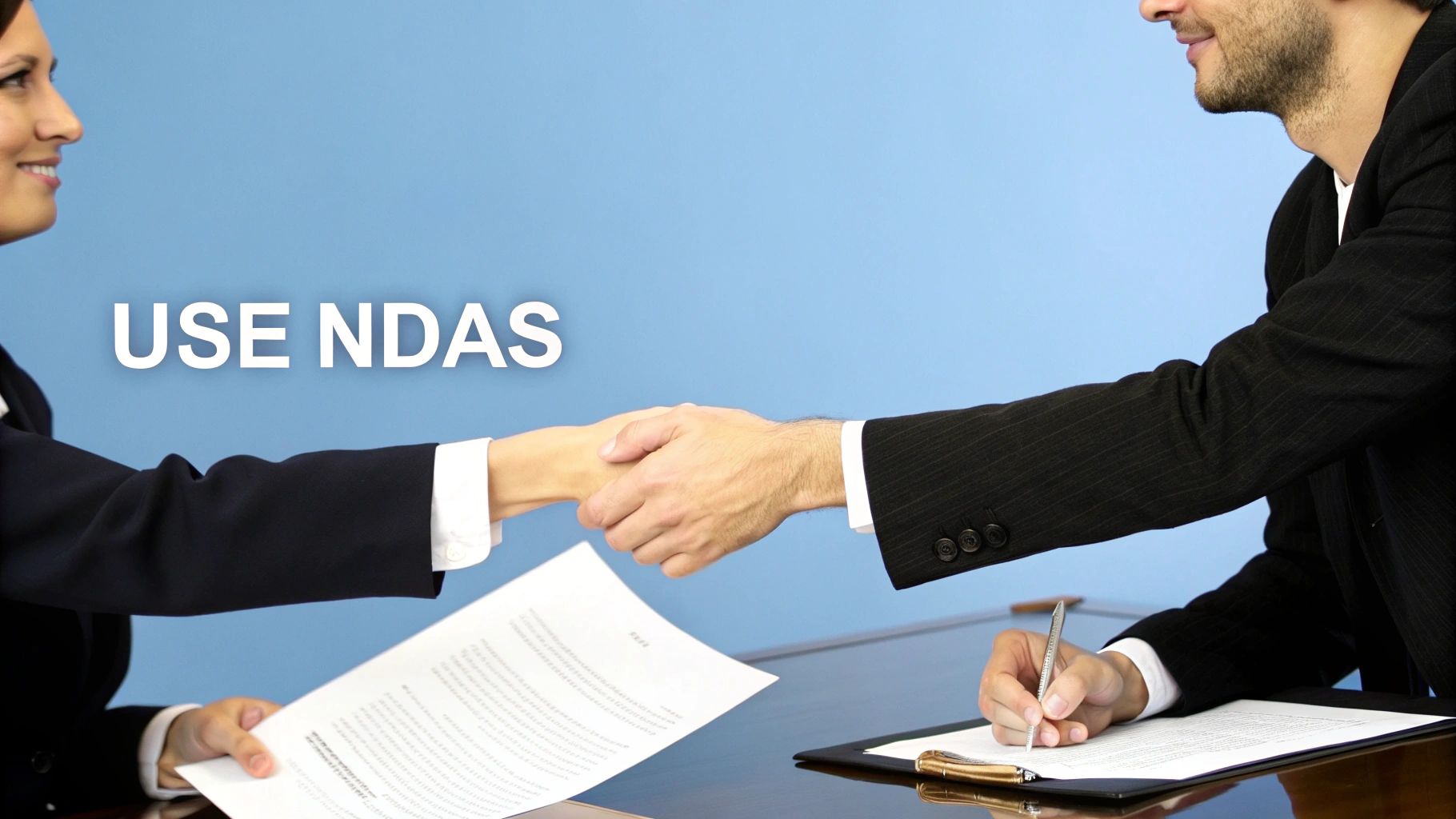
While this automatic protection is a fantastic starting point, relying on it alone can leave you in a tough spot during a legal fight. Think of it like owning a piece of land without having the official deed. To truly lock down your ownership and give yourself maximum legal leverage, you need to formally register your work with the U.S. Copyright Office. It's a strategic move that can make all the difference.
The Power of Formal Copyright Registration
Registering your copyright turns it from a basic right into a rock-solid, enforceable asset. It creates an official public record of your ownership, which is invaluable if you ever have to prove you were the original creator. More importantly, it unlocks some serious legal remedies that are completely off the table otherwise.
The single biggest advantage? The ability to sue for statutory damages and attorney's fees. Without registration, you can only sue for actual damages—the money you can prove you lost because of the infringement. Honestly, this is often incredibly difficult and expensive to calculate, especially for digital content.
Statutory damages change the game entirely. They allow a court to award a set amount for each instance of infringement, ranging from $750 to $150,000 per work. You don't have to prove a specific financial loss. This is a massive deterrent that makes potential infringers think twice.
Imagine you're a freelance photographer and you discover a commercial website using your entire portfolio without permission. If you had registered those photos before the infringement, you could pursue statutory damages for each image. That’s a claim with far more legal teeth than just trying to recoup lost licensing fees.
Practical Steps for Copyright Protection
Beyond just registering, there are simple, everyday habits you can build to reinforce your claim to your work. Think of it as good intellectual property hygiene.
- Use a Copyright Notice: You’ve seen it a thousand times: the © symbol, the year, and the owner's name (e.g., © 2025 Your Company Name). While it’s not legally required for protection in the U.S. anymore, it’s still a smart move. It clearly signals that the work is protected and knocks out any "innocent infringer" defense someone might try to use.
- Keep Meticulous Records: This is huge. Hold on to detailed records of your creative process—drafts, original files with metadata, and a clear timeline of creation. This documentation can be the crucial evidence you need to prove you created the work first.
- Understand 'Work for Hire': If you hire freelancers or contractors to create content, you need to be crystal clear about who owns the copyright. A "work-for-hire" clause in your contract must explicitly state that your company is the legal author and owner from the get-go. If you don't have this, the creator automatically retains the copyright, even though you paid them for the work.
These proactive measures are essential, especially in a world where content is shared and misused in a heartbeat. The fight to protect creative work is a global one. The United States Trade Representative’s 2025 Special 301 Report evaluates IP enforcement in over 100 countries, highlighting actions like the Dominican Republic's seizure of over 10 million counterfeit items. This is all part of a worldwide effort to secure these crucial assets. You can dig into more of these global enforcement insights at USTR.gov.
Knowing how to protect your intellectual property isn't just about reacting to theft; it's about building a proactive defense for your most valuable creative outputs. By combining automatic protection with formal registration and smart daily habits, you create a formidable barrier around your work.
Protecting Your Competitive Edge with Trade Secrets
Not every piece of valuable IP belongs in a government database. Sometimes, your most powerful assets are the ones nobody else knows about. Think about your “secret sauce”—that unique sales process, a hard-won client list, or a proprietary algorithm. Their entire value comes from being kept under wraps.
These are your trade secrets, and they require a completely different protection strategy.
Unlike a patent, which forces you to publicly disclose your invention, a trade secret can last forever, as long as you keep it secret. The Coca-Cola formula is the classic example. It’s been a closely guarded secret for over a century, far outlasting the 20-year lifespan of a typical patent. The trick is taking deliberate, consistent steps to maintain that confidentiality.
At its core, protecting a trade secret is all about controlling access. Who knows the information, and what are they allowed to do with it? This starts with putting the right legal paperwork in place.
Implement Ironclad Legal Agreements
You can't just rely on a handshake or expect people to keep quiet. You need legally binding contracts that explicitly define what’s confidential and what happens if someone spills the beans.
Your most important tool here is a Non-Disclosure Agreement (NDA). Before any employee, contractor, or business partner gets a whiff of sensitive information, they should sign a well-drafted NDA. This creates a legal duty to maintain confidentiality, an obligation that should continue even after their relationship with your company ends.
A huge mistake I see all the time is companies pulling a generic NDA template off the internet. A one-size-fits-all agreement is weak and often difficult to enforce. Your NDA needs to be customized to your business and the specific information you're trying to protect.
Vague language is your enemy. Be crystal clear about what constitutes a "trade secret" for your business. That clarity is what will save you if you ever have to go to court.
Establish Robust Security Measures
Legal agreements are your first line of defense, but they aren't enough on their own. You also need to build a fortress—both digital and physical—to prevent leaks and unauthorized access. From a legal standpoint, you have to prove you took "reasonable measures" to keep the information secret.
This means weaving practical security protocols into your daily operations.
- Control Access: Not everyone needs the keys to the kingdom. Restrict access to sensitive data and physical locations on a strict “need-to-know” basis.
- Encrypt Everything: Encrypting sensitive digital files is non-negotiable, especially for data on servers or shared with remote teams. It’s a powerful shield against data breaches.
- Manage Documents Securely: Slap a “Confidential” label on sensitive documents and create clear rules for how they are stored, handled, and eventually destroyed. A simple paper shredder is a surprisingly powerful IP protection tool.
- Train Your People: Your team is on the front lines. Regular training on the importance of confidentiality and your security rules is essential.
Knowing what your competitors are up to is also part of the puzzle. When you understand what gives you an edge, you'll know which secrets are worth fighting for. Our guide on how to conduct competitive analysis that wins markets can help pinpoint those critical advantages.
Conduct a Trade Secret Audit
It’s impossible to protect what you don’t know you have. A trade secret audit is a proactive step to inventory all of your confidential information and check for weaknesses in your defenses. Think of it as a health check-up for your most valuable secrets—it helps you spot vulnerabilities before they turn into disasters.
Using a structured checklist is the best way to make sure you cover all your bases during an audit.
Here’s a checklist to get you started on building a robust system for safeguarding your company’s confidential information.
Essential Checklist for Trade Secret Protection
By systematically working through these steps, you build layers of protection that make it much harder for your secrets to be compromised, whether by accident or by malicious intent.
What to Do When Someone Steals Your IP
It’s a gut-wrenching feeling. You’ve poured your heart and soul into an idea, only to find someone else using it without your permission. But here's the thing: owning intellectual property is one thing; knowing how to defend it is what gives it teeth.
When you discover an infringement, the initial instinct might be to react emotionally. Don't. A calm, calculated response will get you much further. The goal is to shut down the infringement and recover any losses, not to start an unnecessary war.
Before you even think about reaching out, your first job is to become a detective. You need to build a rock-solid case. That means grabbing screenshots, saving web page links, and if you have to, buying the infringing product. Document everything—the date you found it, where you found it, and how widespread the use is. This evidence is the bedrock of your entire enforcement strategy.
Your First Move: The Cease and Desist Letter
With your proof in hand, the classic first step is sending a cease and desist letter. This is a formal, written demand telling the other party to stop what they're doing—now. You can technically write one yourself, but having an attorney draft it adds a ton of gravity. It signals you're not just complaining; you're serious.
A good cease and desist letter needs to hit a few key points:
- Proof of ownership: Include your trademark registration number, patent details, or copyright filing info.
- The evidence: Be specific. Show them exactly how they are stepping on your rights, using the proof you’ve gathered.
- A clear demand: Tell them precisely what you want them to do (e.g., stop selling the product, remove the content) and give them a firm deadline.
- A warning shot: Make it clear you’re ready to file a lawsuit if they don’t comply.
Honestly, a well-written letter from a lawyer is often enough to solve the problem. Sometimes people genuinely don't know they're infringing, or they'll just decide a legal battle isn't worth the headache.
Smarter Ways to Settle: Exploring Your Options
If they ignore your letter, your mind probably jumps straight to "lawsuit." Hold on. Litigation is a beast—it's expensive, it takes forever, and it’s incredibly stressful. Before you go down that road, it’s smart to look into alternative dispute resolution (ADR).
Mediation can be a game-changer in IP disputes. You bring in a neutral third party who helps you and the other side talk things out and find a solution you can both live with. It’s far less hostile than a courtroom and can even save a business relationship.
Another route is arbitration. Think of it as a private, streamlined court case. A neutral arbitrator hears from both sides and makes a decision that's legally binding. It's more structured than mediation but still a whole lot faster and cheaper than traditional litigation.
The Global Enforcement Puzzle
If your business operates internationally, protecting your IP gets a lot trickier. A U.S. patent or trademark doesn’t mean much in Europe or Asia. You have to enforce your rights in the country where the violation is happening, and that means dealing with a whole different set of laws.
This is where things are getting interesting with new international agreements. Take the Unified Patent Court (UPC) in Europe, which kicked off in mid-2023. It’s designed to create a single court for patent lawsuits across 18 member countries, making it way easier to enforce patents across borders.
It's already making waves. As of January 2025, the court had handled 635 cases, with 239 of those being infringement lawsuits. It’s even attracting what we call non-practicing entities (NPEs) in the tech world. You can get a deeper dive into these trends and how they affect IP insurance in this analysis from Arch Insurance.
The bottom line? A measured, evidence-first approach is your best bet. Document everything, send a firm but professional demand, and always consider smarter, cost-effective options before jumping into a legal fight.
Your brand is your most valuable asset. At Softriver, we create custom logos and full brand identities that give you a professional, memorable presence in the market. Get a timeless, market-aligned design that positions you for long-term success. Discover our branding packages at https://softriver.co.


